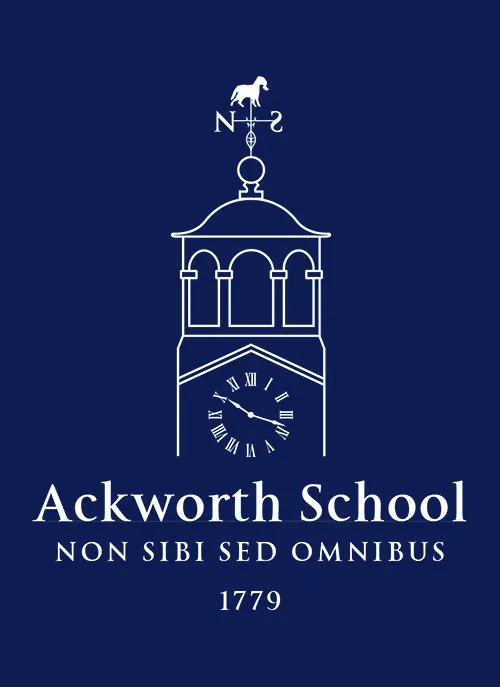
Dominic Sanderson, an old scholar and winner of the Ackworth School Drama Trophy wrote a review of the Junior Production The Light Burns Blue.
When I went to see the junior production of ‘The Light Burns Blue’ directed by Mr Boucher, I wasn’t sure what to expect as this is not a massively well-known play and I myself wasn’t aware of its existence. It is set during WW1 and tells a story of a young Elsie Wright who tricks people into believing that fairies exist due to the supposed photographs she has taken of them. However, a reporter attempts to expose the truth about Elsie’s deceitful behaviour but in the end realises that her act was not out of malice. The way that this production was acted and staged captured my attention, so much so that I decided to read the play for myself which has enlightened me further to its intricacies and challenges. For such a young cast, I think they certainly overcame these challenges and put on an impressively staged performance.
I had heard prior to seeing the performance that it was originally going to be staged in Great Gardens. Viewing the performance in a naturistic setting such as this would have effectively brought the audience closer to the land of the fairies and also added an element of playfulness to the scenes in which people are attempting to look for and capture the fairies, such as scene 18 where Clarence Johnson leads a group through the woods in search of the fairies. It was unfortunate that the weather couldn’t allow the play to take place there, but it was still a clever idea nonetheless and didn’t subtract from some of the other skilfully staged scenes. As I was reading the play, there was one line that I read that took me right back to how one of the earlier scenes was staged during the performance: ‘I know my missing child is safe with the fairies.’ It was the soldier scene (scene 10) as a group of soldiers read out their wills; each soldier was placed at the corners of the stage and after they had read out their wills, the rest of the cast surrounded each individual soldier, almost forming a protective barrier around them. Although they were meant to represent the family of the soldiers, to me, their movements were quite fairylike and could have easily represented the protection of the fairies that would mean the soldiers were ‘safe with the fairies’. This was probably my favourite scene to see staged, not only because of how intelligent and thought-provoking it was, but also due to the way it made the fairies seem hidden but at the same time exposed right in front of the audience – very effective. I’d say the most taxing scenes to stage were the ones where there was a lot of transitioning from one scenario to the next. In scene 2, for example, the action starts in the church and then swiftly moves to a bakery, a shop, a farm, to the village common and then finally to the high street. It seems quite easy to complicate a scene such as this but the way that it was staged in this instance, with the cast forming an arc around the stage and cast members stepping forward seamlessly into their scenario, communicated the scene with clarity.
Overall, the general quality of the acting was superb for such a young cast attempting a play such as this. There is obviously some great potential for these actors to pursue a career in the world of drama and I would definitely encourage this. My advice for the cast members for future productions would be to develop their own self-confidence, as at times lines were lost due to lack of projection and rushing through lines to get them over with quickly. This wasn’t too much of a hindrance and in all fairness, they are only very young, and their confidence will inevitably grow. The acting I paid special attention to was the interaction between Elsie Wright (played by Ella) and the reporter Winifred Douglas (played by Emily) as they have a complex relationship. On the surface, they appear to be enemies as Winifred is trying to prove Elsie to be a fraud; the costumes for this production highlighted this, with most of the cast, including Elsie, wearing a maid’s apron but with Winifred wearing a tailored blazer. These juxtaposed costumes effectively showed the opposition between them and how they are completely against each other. Nevertheless, in reality these characters have the exact same aims in the play and share more in common than we first think – the way the actors interacted during this production certainly showed this. In scene 3 and scene 24 (which is two halves of the same scene), the two actors showed how these characters are very interchangeable; in scene 3, Winifred holds the power as she intimidates Elsie by walking around her whereas in scene 24 the roles are reversed, and Elsie is the one walking around Winifred. This was an effective way of communicating to the audience that there is no dominant character between them and as the play went on it becomes more obvious that actually they are both creative people and both want to tell their own versions of the truth.
All in all, I really enjoyed watching this production and thought that the way Mr Boucher had staged it was clear and clean but also very thought-provoking. Furthermore, I also give credit to the young cast who did an excellent job at communicating the tough ideas that can be associated with this play.

